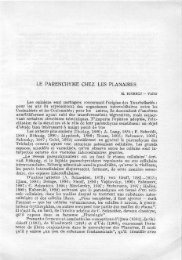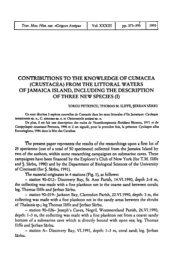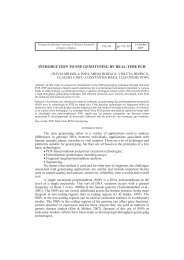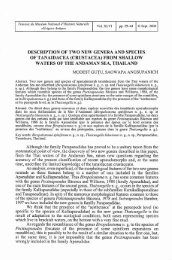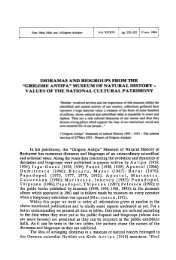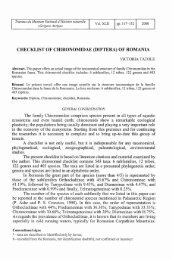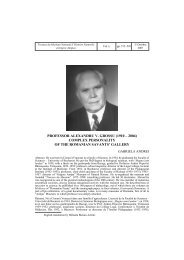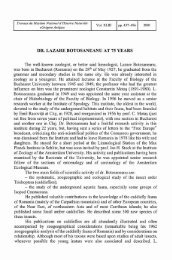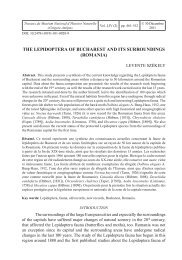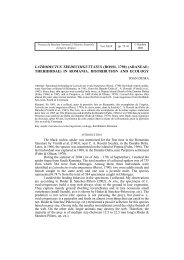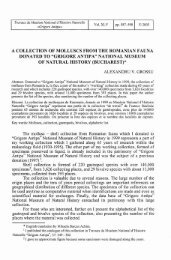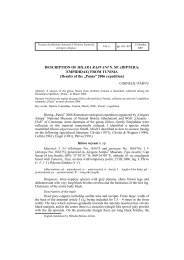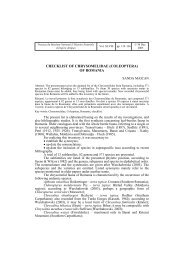ARNOLD - LUCIEN MONTANDON (1852 – 1922 - Travaux
ARNOLD - LUCIEN MONTANDON (1852 – 1922 - Travaux
ARNOLD - LUCIEN MONTANDON (1852 – 1922 - Travaux
Create successful ePaper yourself
Turn your PDF publications into a flip-book with our unique Google optimized e-Paper software.
482 GABRIELA ANDREI, CORNELIU PANDELE<br />
Moldova and Dobrogea, before 1918) and then, referring only to Montandon, he<br />
said «lucrarea sa capitalã, apãrutã în 1906 (…) un fel de inventar, catalog-listã al<br />
tuturor gasteropodelor colectate de el, amintind ºi localitãþile de unde au fost<br />
adunate» (his chief paper, published in 1906 (…) a kind of inventory, listed<br />
catalogue of all gastropods collected by him, also mentioning the collecting<br />
localities) (Andrei, 2005).<br />
In Istoria biologiei în date (The History of Biology with data), published in<br />
1996, in the chapter dedicated to Entomology, Matilda Lãcãtuºu underlines A. L.<br />
Montandon’s contribution, considering him «unul dintre precursorii entomologiei<br />
româneºti» (one of the forerunners of the Romanian entomology), together with<br />
Aristide Caradja, Constantin Hormuzaki and Eduard Fleck, his contemporaries.<br />
Besides he was of French origin and had come in Romania since his juvenile years,<br />
we found out that he published his papers on heteropterans in “Buletinul Societãþii<br />
de ªtiinþe” (Bulletin of the Science Society) from Bucharest, and his scientifical<br />
activity lasted 40 years «aducând o mare contribuþie la cunoaºterea faunei din<br />
România» (having a large contribution to the knowledge of the Romanian fauna). It<br />
is also mentioned that he received «ca specialist renumit» (as a well-known<br />
specialist) material for study from further continents and «ca rezultat al activitãþii<br />
sale a lãsat o valoroasã colecþie de Heteroptere, aflatã astãzi la Muzeul “Grigore<br />
Antipa” » (as a result of his activity he made a valuable heteropteran collection,<br />
today preserved in “Grigore Antipa” Museum).<br />
In 2005, on the ocassion of 100 years celebration since Montandon was<br />
appointed Corresponding Member of the Romanian Academy, a large article<br />
dedicated to the naturalist’s biological view was published in Galaþi (Pandele, 2005).<br />
Even if at least ten books and notes were published during the last decades,<br />
entirely dedicated to the great naturalist, few people know the importance of his<br />
contribution today, not only by the 400 new described taxa, by over 200 papers 1<br />
published in the most known periodical journals, the richness of his entomological<br />
and malacological collections, but also by his entire activity, always for the benefit<br />
of Science, Nature and his Adoptive Country. He was the member of some of the<br />
most famous scientifical societies and collaborated with the great museums of the<br />
world, as Muséum National d’Histoire naturelle de Paris, Museo Civico di Storia<br />
Naturale di Genova, Musée National Hongrois, Muséum entomologique de Berlin,<br />
Museo di Zoologia ed Anatomia comparata della R. Università di Torino, U. S.<br />
National Museum of Natural History etc. (Fig. 1).<br />
As Igor Sienkiewicz wrote, although Montandon did not participated to any<br />
expedition «his prodigious activity he built mostly on the material he received from<br />
dozens of people from all continents, with whom Montandon kept a vast<br />
correspondence. Some were distinguished scientists who co-operated with him;<br />
others, collectors or explorers who set foot in some of the wildest countries of the<br />
world, sent whole entomological treasures to the Bucharest worker, who based on<br />
them described the many exotic species that bear Montandon’s name. (…) His<br />
works gained A. L. Montandon a world wide reputation in the field of both aquatic<br />
and terrestrial Heteroptera, Palaearctic as well as Neotropical (Indo-Malayan and<br />
Australian). His discoveries refer to such different families as Naucoridae,<br />
Belostomatidae, Nepidae, Ranatridae, Berytidae, Lygaeidae, Tingidae, Coreidae,<br />
Pentatomidae, Cydnidae, Plataspidae, etc., etc. » (Sienkiewicz, op. cit.).<br />
Montandon’s name is bounded by the first studies on the fauna of Moldova,<br />
Muntenia and Dobrogea. We found the comment in “Istoricul cercetãrilor”



